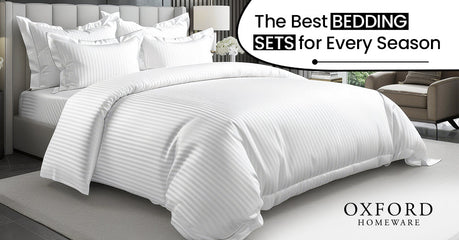The Ultimate Guide to Plain Duvet Covers
A bedding style, a plain duvet cover, features a single hue or a simple pattern without any designs or patterns. It is a classy but understated option for your bedroom decor. A simple duvet cover has numerous advantages, including adaptability, simplicity in coordinating with other bedding and décor, and a timeless appearance. This article will cover the varieties of plain duvet covers, things to consider when selecting one, how to care for it, and style advice.
Benefits Of A Plain Duvet Cover
Using a basic duvet cover has a lot of advantages, including the following:
Versatility:
Their versatility allows plain duvet covers to be mixed with various colours and designs. They are thus a fantastic option for folks who often alter the look of their bedrooms.
Timelessness:
Plain duvet covers offer a classic, timeless appearance that is always in vogue. They may blend in with various décor types, including classic and contemporary.
Relaxation
A simple duvet cover may make your bedroom serene. The absence of hectic patterns and vibrant colours may aid in creating a calm and quiet environment.
Personalisation
Blankets and comforters with no designs on them are the perfect places to express your individuality. Embellish the space with throw blankets, throw cushions, and other accessories to make it your own.
Simple Care
Plain duvet covers are often simple to look after. They don't need particular care or consideration and may be machine cleaned and dried.
In general, a plain duvet cover may be a functional, fashionable, and versatile option for your bedroom.
Plain Duvet Covers Of Various Types
Cotton Plain Duvet Covers
Due to their softness, longevity, and breathability, cotton is a popular material for duvet covers. From crisp percale to smooth sateen, plain cotton duvet covers are available in various thread counts, weaves, and finishes.
Plain Linen Duvet Covers
These covers offer a distinct feel and a laid-back, organic appearance. They are very breathable, wick away moisture, and are hypoallergenic.

Silk Plain Duvet Covers
Silk has a plush feel and a shiny finish on its duvet covers. They naturally control body temperature and are hypoallergenic.
Microfiber Plain Duvet Covers
Made of synthetic material, microfiber has the same softness and feels like natural fibres. It is inexpensive, crease-resistant, and long-lasting.

Sateen Plain Duvet Covers
Sateen is a cotton weave that gives off a smooth, silky texture with some shine. Sateen plain duvet covers offer an opulent look and feel.

Tips For Choosing A Plain Duvet Cover
- Composition: Your duvet cover's softness, breathability, and durability depend on its composition.
- Thread Count: Thread count refers to the total number of threads per square inch of fabric. A cloth with a greater thread count is often softer and more robust.
- Weaving: The weaving may affect your duvet cover's texture and look.
- Size: Make sure the duvet cover you purchase will fit your comforter or duvet.
-
Colour: Consider how the duvet cover's colour will look with the rest of your bedding and décor. If you're looking to add a touch of simplicity and elegance to your bedroom, consider our collection of plain duvet covers. Our collection features a variety of colors to choose from, including navy, black, light blue, red, white, cream, charcoal, purple, pink, ochre, grey, and silver.
- Cost: The cost of plain duvet covers ranges, so consider that while choosing.
How Should You Care For A Plain Duvet Cover?
Proper care is required to maintain your plain duvet cover feeling and look its best. Ad adheres to these maintenance guidelines to keep your duvet cover clean, fresh, and lovely.
Washing and Drying
Check the care label on your duvet cover for precise cleaning instructions before washing and drying. Most simple duvet covers may be laundered in the washing machine on a gentle cycle with a light detergent. Use warm water; avoid hot water, which might harm the fibres. The duvet cover should be removed from the dryer when it is still slightly moist to avoid wrinkles and should then be hung up or laid flat to complete drying.
Ironing
Most plain duvet covers don't need to be ironed, but if you want a crisp appearance, use a low heat setting. The care label should always be read first since certain fabrics cannot be ironed.
Storage
Make sure your simple duvet cover is tidy and thoroughly dry before putting it away. Fold it neatly and store it in a cool, dry place away from moisture or direct sunshine. Your duvet cover should be kept in a plastic bag since doing so might make it musty or mildew-prone.
Matching Other Bedroom Decor With Your Plain Duvet Cover
- Pillows: Match pillows with comparable hues and textures to your basic duvet cover.
- Sheets: Use sheets in a neutral or complementary shade to achieve a unified aesthetic.
- Curtains: To create a unified aesthetic in your bedroom, choose curtains that are the same shade as your duvet cover or a hue that complements it.
- Wall decor: To unify your bedroom's design, use decorative items or artwork in shades that go well with your duvet cover.
Tips For Styling Your Plain Duvet Cover
- Layering: Layer your duvet cover with various textures and hues to create a visually appealing, comfortable bedding combination.
- Adding Textures: To add depth and interest to a simple duvet cover, use pillows, throws, and blankets with various textures, such as knits or fur.
- Adding Accent Colours: To add visual appeal to your plain duvet cover, add accent colours via ornamental cushions, blankets, or artwork.
- Combining And Matching Patterns: You may still mix and match patterns in your bedding set for a more eclectic appearance, even if plain duvet covers are simple to coordinate.
Frequently Asked Questions
What is a duvet cover?
A duvet cover is a detachable garment that covers a duvet, a plush blanket filled with down or artificial fibres. Duvet covers are used to preserve the duvet and alter the appearance of your bedding. Finding them in several textures, colours, and styles is possible.
What duvet cover size should I purchase?
The size of your duvet will determine what size duvet cover you should choose. Make sure to measure your duvet before selecting a cover. Single, double, king and super king are the typical duvet cover sizes in the UK.
Can I pair patterned pillows with a plain duvet cover?
Yes, you may pair patterned pillows with a plain duvet cover. A plain duvet cover may assist in creating a unified aesthetic in your bedding by balancing out the vital patterns and hues of patterned pillows.
Is using a plain duvet cover in a child's room OK?
Yes, a child's bedroom can look fantastic with a simple duvet cover. They are adaptable and go well with various hues and designs. Additionally, they are often simple to maintain, which is crucial for children's bedding.
How frequently should a plain duvet cover be washed?
You should wash your simple duvet cover every one to two weeks or as often as required. Regular washing will maintain it fresh and clean and stop the accumulation of dirt and dust. Avoid using hot water or abrasive detergents that might ruin the fabric, and instead, adhere to the care directions on the label.
Why pick a plain duvet cover over one with patterns?
While patterned duvet covers may be vivid and eye-catching, it cannot be easy to coordinate them with other bedding and décor. On the other hand, a simple duvet cover is a flexible and helpful option since it can be readily matched with many décor styles and hues.
Conclusion
A plain duvet cover is a flexible and classic option for your bedding set. When selecting a simple duvet cover, consider the fabric, thread count, weave, size, colour, and price. You should also pay attention to the washing and storing recommendations.
Match your simple duvet cover with other bedding and accessories to make your bedroom seem unified and aesthetically appealing. With the help of these suggestions, you may design a chic and cosy bedroom that represents your own preferences.


